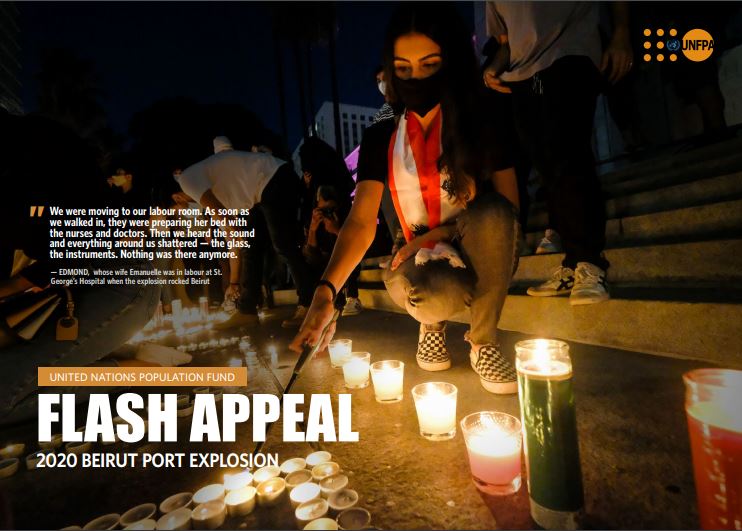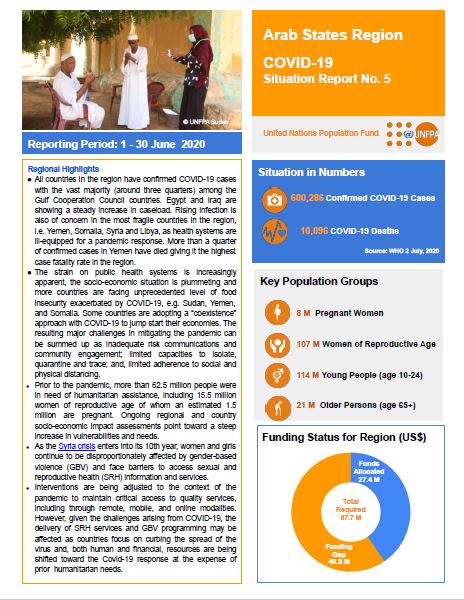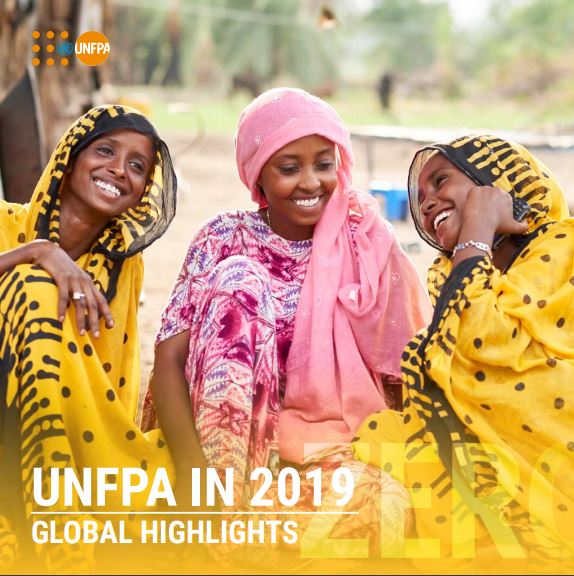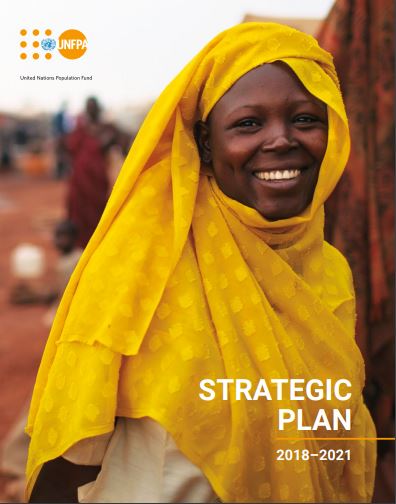You are here
New Releases

Flash Appeal: 2020 Beirut Explosion
On 4 August, 2020, at approximately 18h00 (local time), a warehouse at the Beirut Port containing large quantities of ammonium nitrate exploded. The initial explosion was followed by a much more substantial subsequent blast that caused widespread damage reportedly reaching more than 20 kilometres from the port area. As of August 11, the death toll from the incident stands at more than 170 and is continually rising as more bodies are recovered from the surrounding wreckage. More than 5,000 people were injured in the blast, with more than 300,000 displaced and dozens reported missing since the incident.
The Beirut Port explosion has created yet another large-scale crisis in a country that is in the midst of a serious economic crisis as well as the COVID-19 pandemic. To respond to these challenges, UNFPA is urgently appealing for US$ 19.65 million to provide lifesaving assistance and meet the emerging needs of those impacted by this crisis.
More details can be found in this Flash Appeal.

FAMILY PLANNING PROGRAMMING: a regional paper based on four case studies in the Arab states
Family planning is central to gender equality and women and girls’ empowerment, and it is a key factor in reducing poverty. The Programme of Action of the International Conference on Population and Development (ICPD) recognized “the right of men and women to be informed and to have access to safe, effective, affordable and acceptable methods of family planning of their choice.” UNFPA, the United Nations sexual and reproductive health agency, supports voluntary family planning, including procuring contraceptives, supply chain management, and training health professionals to accurately and sensitively counsel individuals about their family planning options. A holistic and sustainable approach to family planning is essential to ensure that family planning needs are met, every individual can choose their preferred method, and most importantly to reduce maternal and child mortality.
It is for these reasons that UNFPA’s Regional Office for the Arab states launched a call for the country offices to seek promising family planning programmes and good practices that could be scaled-up in other countries in the region. From the submitted initiatives, four were selected to be documented and shared with relevant stakeholders.

COVID-19 Situation Report No. 6 for UNFPA Arab States
The UN Secretary-General’s policy brief on the impact of COVID-19 on the Arab region highlights the likely devastating effects of the pandemic. The economy could contract by over 5% and one quarter of the population may end up in poverty. Some communities will be especially hard hit, including women, migrants and the more than 62 million people already in need of humanitarian assistance prior to COVID-19. Those caught in armed conflict face particular challenges.
The brief also highlights that the response to the pandemic is an opportunity to address long-standing conflicts and structural weaknesses, and recommends four sets of priorities.
The policy brief underlines the importance of continued international support to countries in the region to successfully weather this crisis and build back better. UNFPA engages in these priorities at regional and country level through the various socio-economic frameworks that are being developed and rolled out.
In the immediate term, preventing the spread of COVID-19 through public health measures and providing support in the context of the country preparedness response plans remains a priority as the strain on health systems is increasingly apparent, the socio-economic situation is plummeting and more countries are facing unprecedented food insecurity exacerbated by COVID-19, e.g. Sudan, Yemen, and Somalia.
Major challenges in mitigating the pandemic include inadequate risk communications and community engagement; limited national capacities to isolate, quarantine and trace; and limited adherence to social and physical distancing.

COVID-19 Situation Report No. 5 for UNFPA Arab States
Regional Highlights
All countries in the region have confirmed COVID-19 cases with the vast majority (around three quarters) among the Gulf Cooperation Council countries. Egypt and Iraq are showing a steady increase in caseload. Rising infection is also of concern in the most fragile countries in the region, i.e. Yemen, Somalia, Syria and Libya, as health systems are ill-equipped for a pandemic response. More than a quarter of confirmed cases in Yemen have died giving it the highest case fatality rate in the region.
The strain on public health systems is increasingly apparent, the socio-economic situation is plummeting and more countries are facing unprecedented level of food insecurity exacerbated by COVID-19, e.g. Sudan, Yemen, and Somalia. Some countries are adopting a “coexistence” approach with COVID-19 to jump start their economies. The resulting major challenges in mitigating the pandemic can be summed up as inadequate risk communications and community engagement; limited capacities to isolate, quarantine and trace; and, limited adherence to social and physical distancing.
Prior to the pandemic, more than 62.5 million people were in need of humanitarian assistance, including 15.5 million women of reproductive age of whom an estimated 1.5 million are pregnant. Ongoing regional and country socio-economic impact assessments point toward a steep increase in vulnerabilities and needs.
As the Syria crisis enters into its 10th year, women and girls continue to be disproportionately affected by gender-based violence (GBV) and face barriers to access sexual and reproductive health (SRH) information and services.
Interventions are being adjusted to the context of the pandemic to maintain critical access to quality services, including through remote, mobile, and online modalities. However, given the challenges arising from COVID-19, the delivery of SRH services and GBV programming may be affected as countries focus on curbing the spread of the virus and, both human and financial, resources are being shifted toward the Covid-19 response at the expense of prior humanitarian needs.

State of World Population Highlights 2020
Every day, hundreds of thousands of GIRLS around the world are harmed physically or psychologically, or both, with the full knowledge and consent of their families, friends and communities. The impact ripples throughout society, reinforcing gender stereotypes and inequalities. The scope of harmful practices is vast, but three in particular have been almost universally denounced as human rights violations yet remain stubbornly widespread: female genital mutilation, child marriage and son preference.
These practices cross borders and cultures. They vary in the specifics of their execution—a girl may have her genitals cut in infancy or adolescence, she may be married off to “protect” her from rape or as part of a trade, she may be erased before birth or
neglected to death after. But these practices are alike in origin; they are rooted in gender inequality and a desire to control female sexuality and reproduction. Though they inflict a devastating array of harms on individual women and girls, the harms inflicted on the world at large, and on future generations, may be greater still.
As the health, education and human potential of women and girls are diminished, so too is humanity. But we have the power to defy the forces that perpetuate harm and to realize a world where every woman and girl is free to chart her
own future.

State of World Population 2020
Every day, tens of thousands of girls have their health, rights and futures stolen. Some are subjected to female genital mutilation. Some are forced into “marriages” as children, and still others are neglected or starved, simply because they are female.
In many instances, parents who subject their daughters to harmful practices may do so with good intentions. They wrongly accept that female genital mutilation must factor into acceptance by peers in communities where this practice is widespread.
They mistakenly believe that marrying off a child will secure her future. Some are unaware of the physical and psychological health risks. Good intentions, however, mean little to the girl who must abandon school and her friends to be forcibly wed, or to the girl who faces a lifetime of health problems because of mutilation from a harmful rite of passage.
In 1994, at the International Conference on Population and Development, ICPD, world governments called for universal sexual and reproductive health and decisively demanded an end to harmful practices. One year later, at the Fourth World Conference on Women, governments again declared that harmful practices must stop. Progress in slowing the rate of some adverse practices has been achieved, yet because of population growth, the number of girls subjected to harm is actually growing. Clearly, pledges and resolutions have not been sufficient to end harmful practices once and for all.
What we need now are real change and real results. Last year, at the Nairobi Summit on ICPD25, representatives from governments, grassroots organizations, development agencies and the private sector moved beyond pledges and resolutions and committed to ending the unmet need for contraceptives, ending preventable maternal death, and ending gender-based violence and harmful practices.
This year begins a “decade of action” to achieve the Sustainable Development Goals by 2030, including target 5.3 on ending harmful practices. To meet our objective and protect the millions of women and girls whose bodily integrity is threatened, now is
the time to push harder. The pace of our progress must be faster. Governments must meet their obligation to protect girls and women from harm. Human rights treaties, such as the Convention on the Rights of the Child, direct governments to “take all effective and appropriate measures with a view to abolishing traditional practices prejudicial to the health of the children”.
Getting to zero may prove difficult, yet I have no doubt it is achievable. After all, some harmful practices have persisted over centuries. Yet change will—and must—come. The first step in changing attitudes and social norms is educating parents about the consequences harmful practices have for their daughters and about the benefits that accrue to families and communities when girls are healthy and empowered, and their rights are respected. We know that actions that put women, men, girls and boys on
an equal footing in all spheres in life can help transform long-standing traditions of harm. We know that dismantling patrilineal property and inheritance systems can also help dismantle the institution of child marriage. We know what works. And we now also know what it would cost to end the two most common harmful practices, female genital mutilation and child marriage: a well-spent $3.4 billion a year, on average, from 2020 through 2030, to end the suffering of an estimated 84 million girls. Armed with knowledge, backed by international human rights agreements, and buoyed by new commitments by governments and civil society, we have the power to defy the forces that perpetuate harm and to realize a world where every woman and girl is free to chart her own future.

REPORTING ON GENDER-BASED VIOLENCE DURING PUBLIC HEALTH CRISES
During pandemics, lockdowns, curfews and other restrictions on movement are deemed necessary preventative health measures that can save millions of lives. For women and girls, however, they are also sources of increased risk of violence and death. Organisations working to
combat gender-based violence (GBV) worldwide have issued an unsettling amount of reports showing that more GBV is occurring against the backdrop of the COVID-19 pandemic. These reports have underscored the fact that many of the measures deemed necessaryfor controlling a viral outbreak are not only exacerbating GBV-related risks but also significantly limiting the ability of survivors to shield themselves from their abusers, all the while limiting or severing their access to life-saving support. This has been documented repeatedly during previous epidemics throughout the globe, during which women were also observed to take on additional physical, psychological and time burdens as caregivers.

Multi-sectoral Arab Strategy for Maternal, Child, and Adolescent Health 2019-2030
In spite of the decrease in maternal and child mortality ratios in the Arab region between 1990 and 2015 to levels below the global average (as the child mortality rate fell by 63% while maternal mortality ratio decreased by 56%), there are many challenges in the Arab region that still need more efforts and the presence of political and financial support, in order to achieve partnerships, cooperation, and knowledge sharing between Arab countries, in order to invest in enhancing the health of mothers, children, and adolescents, in higher rates, so as to achieve the SDGs.
Maternal and child health is considered a vital determinant that reflects the general health situation in societies and countries, not only as a measure of the health of mothers and children, but also as a measure of the maternal and child health within the context of the eight MDGs (2000-2015), that later on became among the targets of SDGs (2016-2030), in which goal 3 is concerned with health, and it became among the targets of the global strategy for maternal, child and adolescent health (Every Woman EveryChild 2016 -2030) which targets the reduction of maternal mortality ratio to less than 70 deaths per 100,000 live births. It also targets the decrease in child mortality rate of children under 5 years to less than 25 per 1000 live births, while decreasing newborn mortality rate to less than 12 per 1000 live births.
The Arab region shares with other regions in the world their concern for enhancing the health of mothers, children, and adolescents, as well as sharing the international commitments to achieve SDGs (2016-2030). The region also supports the global strategy on maternal, child, andadolescent health. This concern motivated Arab Health Ministers’ council’s decision number 3 issued during the ordinary session 45, held 2-3 March 2016 about “enhancing maternal, child, and adolescent health in the Arab region”, which stated in its third article on, inviting the concerned technical committee to develop a multi-sectoral Arab strategy for maternal, child, and adolescent health. The strategy shall have specific goals and targets. The committee will develop an Arab database in order to draw a health map with all relevant indicators. It will investigate the possibility of supporting Arab states with limited capacities in enacting and utilizing the strategic plan, in order to achieve the relevant SDGs 2030”.
There are some common challenges among the Arab states, standing in the way of fulfilling the health targets. These include the weakness and fragmentation of health systems; the low rate of accessibility to services, especially among the groups that need services the most; gaps
in the availability of healthcare workforce; the presence of gaps between states and within states in terms of health indicators; the inequalities in achieving targets; and the weak financial support available in low-capacity countries.

Annual Report 2019
UNFPA has set out to achieve three world-changing results by 2030: Zero unmet need for family planning, zero preventable maternal death, and zero gender-based violence, including harmful practices like child marriage and female genital mutilation.
The organization’s 2018-2021 strategic plan charted the path towards realizing these goals, which were resoundingly endorsed by thousands of delegates from governments, grassroots organizations, development agencies and private sector partners at the Nairobi Summit on ICPD25. The Summit, held in November 2019, secured more than 1,250 concrete commitments and billions of dollars in support of these transformative goals.
There are already encouraging signs of progress, with many countries advancing on their commitments, and with UNFPA’s programmes continuing to deliver for millions of the most vulnerable women and girls. But progress towards the three zeros is also facing its first major stumbling block: The COVID-19 pandemic, an unprecedented public health crisis that has strained health systems, disrupted supply chains, and driven many programmes and services to a halt.
This snapshot of progress in 2019 gives a view of the organization’s work before the impacts of the pandemic were felt, underlining what can be achieved with global solidarity and resolve.

UNFPA Strategic Plan 2018 - 2021
Imagine a world where
every pregnancy is wanted
every childbirth is safe and
every young person's potential is fulfilled
This is the world we are striving to realize. Our goal is to achieve universal access to sexual and reproductive health, realize reproductive rights, and reduce maternal mortality to accelerate progress on the agenda of the Programme of Action of the International Conference on Population and Development (ICPD), to improve the lives of women, adolescents and youth, enabled by population dynamics, human rights and gender equality. Our new strategic plan is designed to drive the ambitions and goals of the ICPD and 2030 agendas.